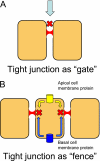Do cell junction protein mutations cause an airway phenotype in mice or humans?
- PMID: 21297078
- PMCID: PMC3175552
- DOI: 10.1165/rcmb.2010-0498TR
Do cell junction protein mutations cause an airway phenotype in mice or humans?
Abstract
Cell junction proteins connect epithelial cells to each other and to the basement membrane. Genetic mutations of these proteins can cause alterations in some epithelia leading to varied phenotypes such as deafness, renal disease, skin disorders, and cancer. This review examines if genetic mutations in these proteins affect the function of lung airway epithelia. We review cell junction proteins with examples of disease mutation phenotypes in humans and in mouse knockout models. We also review which of these genes are expressed in airway epithelium by microarray expression profiling and immunocytochemistry. Last, we present a comprehensive literature review to find the lung phenotype when cell junction and adhesion genes are mutated or subject to targeted deletion. We found that in murine models, targeted deletion of cell junction and adhesion genes rarely result in a lung phenotype. Moreover, mutations in these genes in humans have no obvious lung phenotype. Our research suggests that simply because a cell junction or adhesion protein is expressed in an organ does not imply that it will exhibit a drastic phenotype when mutated. One explanation is that because a functioning lung is critical to survival, redundancy in the system is expected. Therefore mutations in a single gene might be compensated by a related function of a similar gene product. Further studies in human and animal models will help us understand the overlap in the function of cell junction gene products. Finally, it is possible that the human lung phenotype is subtle and has not yet been described.
Figures






Similar articles
-
Drosophila basement membrane collagen col4a1 mutations cause severe myopathy.Matrix Biol. 2012 Jan;31(1):29-37. doi: 10.1016/j.matbio.2011.09.004. Epub 2011 Oct 18. Matrix Biol. 2012. PMID: 22037604
-
Expression of a human surfactant protein C mutation associated with interstitial lung disease disrupts lung development in transgenic mice.J Biol Chem. 2003 Dec 26;278(52):52739-46. doi: 10.1074/jbc.M309599200. Epub 2003 Oct 2. J Biol Chem. 2003. PMID: 14525980
-
Extracellular matrix: recent advances on its role in junction dynamics in the seminiferous epithelium during spermatogenesis.Biol Reprod. 2004 Aug;71(2):375-91. doi: 10.1095/biolreprod.104.028225. Epub 2004 Apr 28. Biol Reprod. 2004. PMID: 15115723 Review.
-
HIF-1-Dependent TGM1 Expression is Associated with Maintenance of Airway Epithelial Junction Proteins.Lung. 2016 Oct;194(5):829-38. doi: 10.1007/s00408-016-9918-8. Epub 2016 Jul 16. Lung. 2016. PMID: 27423780
-
Genetic diseases of junctions.J Invest Dermatol. 2007 Dec;127(12):2713-25. doi: 10.1038/sj.jid.5700727. J Invest Dermatol. 2007. PMID: 18007692 Review.
Cited by
-
Claudin-7 modulates cell-matrix adhesion that controls cell migration, invasion and attachment of human HCC827 lung cancer cells.Oncol Lett. 2019 Mar;17(3):2890-2896. doi: 10.3892/ol.2019.9909. Epub 2019 Jan 8. Oncol Lett. 2019. PMID: 30854065 Free PMC article.
-
Breaking barriers. New insights into airway epithelial barrier function in health and disease.Am J Respir Cell Mol Biol. 2014 May;50(5):857-69. doi: 10.1165/rcmb.2013-0541RT. Am J Respir Cell Mol Biol. 2014. PMID: 24467704 Free PMC article. Review.
-
Neutrophil elastase cleaves epithelial cadherin in acutely injured lung epithelium.Respir Res. 2016 Oct 17;17(1):129. doi: 10.1186/s12931-016-0449-x. Respir Res. 2016. PMID: 27751187 Free PMC article.
-
Harnessing traditional medicine: A dual-action antimicrobial combination against pathogens.iScience. 2025 Mar 20;28(4):111910. doi: 10.1016/j.isci.2025.111910. eCollection 2025 Apr 18. iScience. 2025. PMID: 40463964 Free PMC article.
References
-
- Schaedel C, Marthinsen L, Kristoffersson AC, Kornfalt R, Nilsson KO, Orlenius B, Holmberg L. Lung symptoms in pseudohypoaldosteronism type 1 are associated with deficiency of the alpha-subunit of the epithelial sodium channel. J Pediatr 1999;135:739–745. - PubMed
-
- Cereijido M, Contreras RG, Flores-Benítez D, Flores-Maldonado C, Larre I, Ruiz A, Shoshani L. New diseases derived or associated with the tight junction. Arch Med Res 2007;38:465–478. - PubMed
-
- Van Itallie CM, Anderson JM. Claudins and epithelial paracellular transport. Annu Rev Physiol 2006;68:403–429. - PubMed
Publication types
MeSH terms
Substances
Grants and funding
LinkOut - more resources
Full Text Sources
Medical

